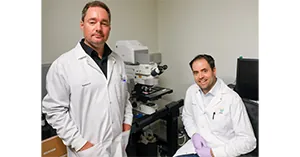
Groundbreaking Discovery Reveals Superbugs Employ Double Defense Against Antibiotics!
2024-11-04
Author: Wei Ling
Introduction
A groundbreaking study reveals that superbugs, specifically Methicillin-resistant Staphylococcus aureus (MRSA), have developed a chilling double defense mechanism against antibiotics, marking a significant advancement in our understanding of antibiotic resistance.
The Threat of Superbugs
According to the World Health Organization (WHO), these superbugs pose one of the most formidable threats to global health, responsible for an astonishing 1.27 million deaths annually. Among the 15 most dangerous microorganisms, MRSA stands out as a notorious adversary.
MRSA's Growing Impact
MRSA alone claims around 120,000 lives each year and has transformed into a serious global health crisis. The research spearheaded by Simon Foster from the University of Sheffield unveils the complex strategies these bacteria use to resist treatment. While methicillin was historically the go-to antibiotic for tackling MRSA, its effectiveness has significantly dwindled, leading to the emergence of this formidable pathogen that now shows resistance to nearly all beta-lactam antibiotics.
Challenges in Treatment
Foster explains that while MRSA can sometimes be treated with other antibiotics such as linezolid or tetracycline, serious infections require more potent options like daptomycin or vancomycin. However, alarming resistance patterns have begun to surface against these treatments as well.
The Discovery of Double Defense
The study delves into MRSA's unique genetic makeup, revealing that it possesses a gene called MecA, which plays a crucial role in its cell wall formation. Initially, researchers believed that other small genetic modifications, referred to as “enhancers,” were key to strengthening MecA’s efficacy. However, this new research flips that assumption upside down. Instead of just enhancing MecA, MRSA utilizes an alternative division method in the presence of antibiotics, enabling its survival despite the onslaught of treatments.
Mechanisms of Resistance
This double feature of resistance means MRSA can evade antibiotics through two complementary mechanisms: a baseline level of resistance facilitated by MecA, and a heightened level achieved through its newly discovered division strategy, which allows it to sidestep traditional bacterial growth methods that antibiotics target. This discovery could have profound implications, unlocking pathways for new therapeutic strategies designed specifically to combat MRSA.
Expert Insights
Bruno González-Zorn, an expert in antimicrobial resistance, highlights the importance of understanding MRSA's unique biology. He underlines that knowledge of these mechanisms can eventually lead to the creation of innovative inhibitors that can potentially counteract MRSA's formidable resistance.
Maria del Mar Tomás, another microbiologist, emphasizes that this breakthrough points toward a more intricate tapestry of resistance. By integrating insights on stress response and tolerance methods, the study links MRSA’s growth abnormalities with its drug resistance, offering a clearer picture of how these bacteria persist in hostile environments.
Broader Implications
This research throws open the door to a new avenue of inquiry, prompting scientists to explore whether similar defense mechanisms exist in other antibiotic-resistant pathogens. Foster suggests that their findings may indicate a broader spectrum of resistance strategies shared among various bacteria, necessitating a thorough investigation into these potential common threads.
Conclusion
As antibiotic resistance rises to unprecedented levels, the urgent need for novel treatments is more crucial than ever. The implications of this latest discovery could pave the way for innovative strategies in the fight against superbugs, shaping the future of infectious disease control and management. Stay tuned, as this ongoing research could unveil even more surprising revelations that could change the way we tackle antibiotic resistance forever!


 Brasil (PT)
Brasil (PT)
 Canada (EN)
Canada (EN)
 Chile (ES)
Chile (ES)
 España (ES)
España (ES)
 France (FR)
France (FR)
 Hong Kong (EN)
Hong Kong (EN)
 Italia (IT)
Italia (IT)
 日本 (JA)
日本 (JA)
 Magyarország (HU)
Magyarország (HU)
 Norge (NO)
Norge (NO)
 Polska (PL)
Polska (PL)
 Schweiz (DE)
Schweiz (DE)
 Singapore (EN)
Singapore (EN)
 Sverige (SV)
Sverige (SV)
 Suomi (FI)
Suomi (FI)
 Türkiye (TR)
Türkiye (TR)